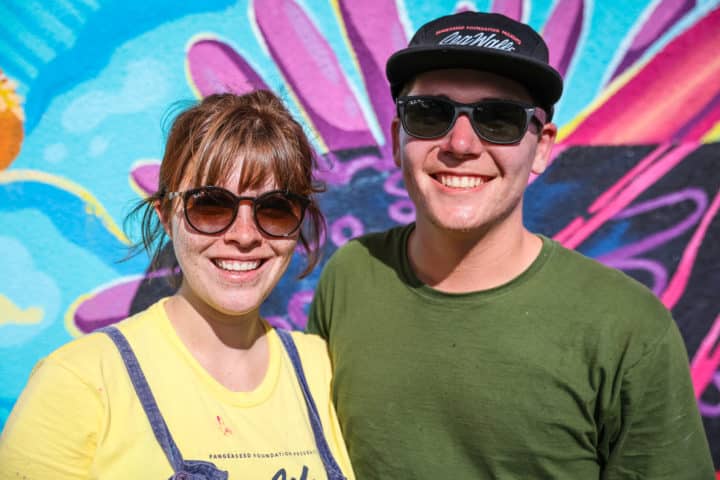
Meet a Wavemaker: Artists Alexandra Underwood & Joey Rose
March 4, 2019🌊 In Bow Seat’s “Meet a Wavemaker” series, we highlight the work of individuals, communities, or organizations who are making waves and inspiring positive change for our oceans: through art, activism, research, or all of the above! 🌊
We met California-based artists Alexandra Underwood and Joey Rose while in Maui, Hawaii for PangeaSeed Foundation’s Sea Walls: Artists for Oceans mural festival. This dynamic duo collaborated on a mural that focused on ocean acidification – sometimes referred to as “global warming’s evil twin.” We picked their brains about their art practices, how they blend creativity and conservation in the studio and through public art, and what advice they have for young emerging ARTivists.
What is your background(s) as an artist? How would you describe your style or practice?
Alex: I started doing art in high school, with help from the most amazing art teacher, Janet Sato. From then, I went on to California College of the Arts and graduated in 2017 with a degree in Illustration. For the past year, I’ve been working as a graphic artist at PopSockets, as well as doing freelance illustration and murals with Joey. I’m still working to define my practice and find that balance between personal work and my job, but in my personal work I love to focus on fun! My goal with each piece is to bring out a smile, whether through color or the imagery itself. We take in so much everyday – through the news, our phones, our environments – that if I get to put one more thing in front of you, it’s my personal goal to make it bright, a breath of fresh air! Pattern is also an important aspect of my practice; the meditative act of painting patterns plays a big part in the process and the final piece.
Joey: I’m a painter, illustrator, and muralist. My mom was my first art teacher, so I’ve been drawing, painting and sculpting my whole life. I graduated from California College of the Arts a year-and-a-half ago with a degree in Illustration. I would describe my style as magic realism. I like to have one foot in reality and one foot in the fantastic. I generally paint large-scale with acrylics.
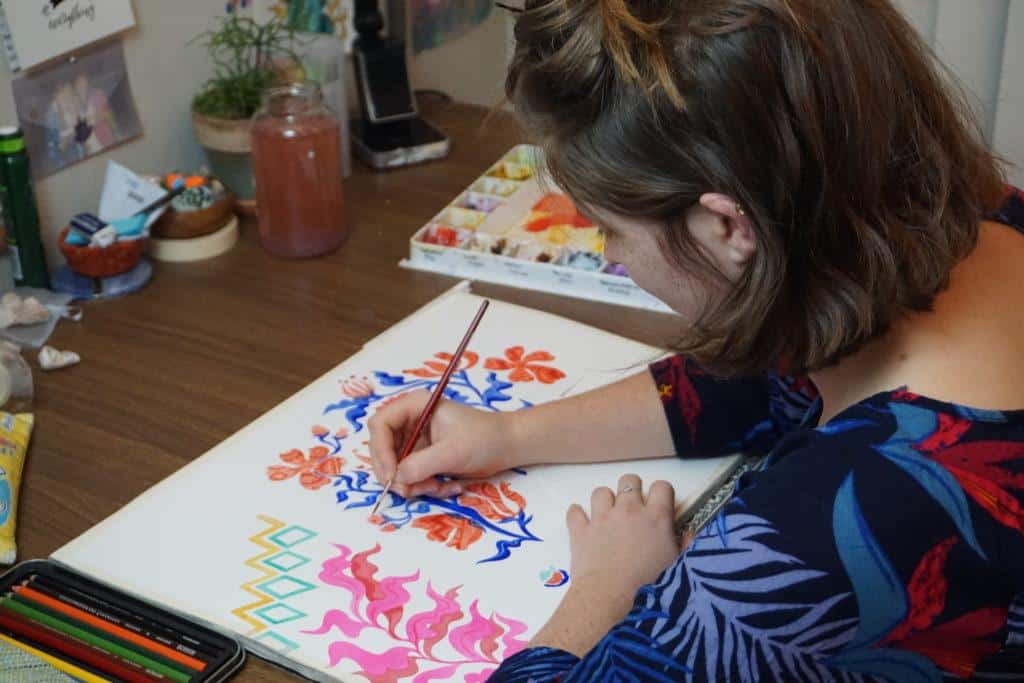
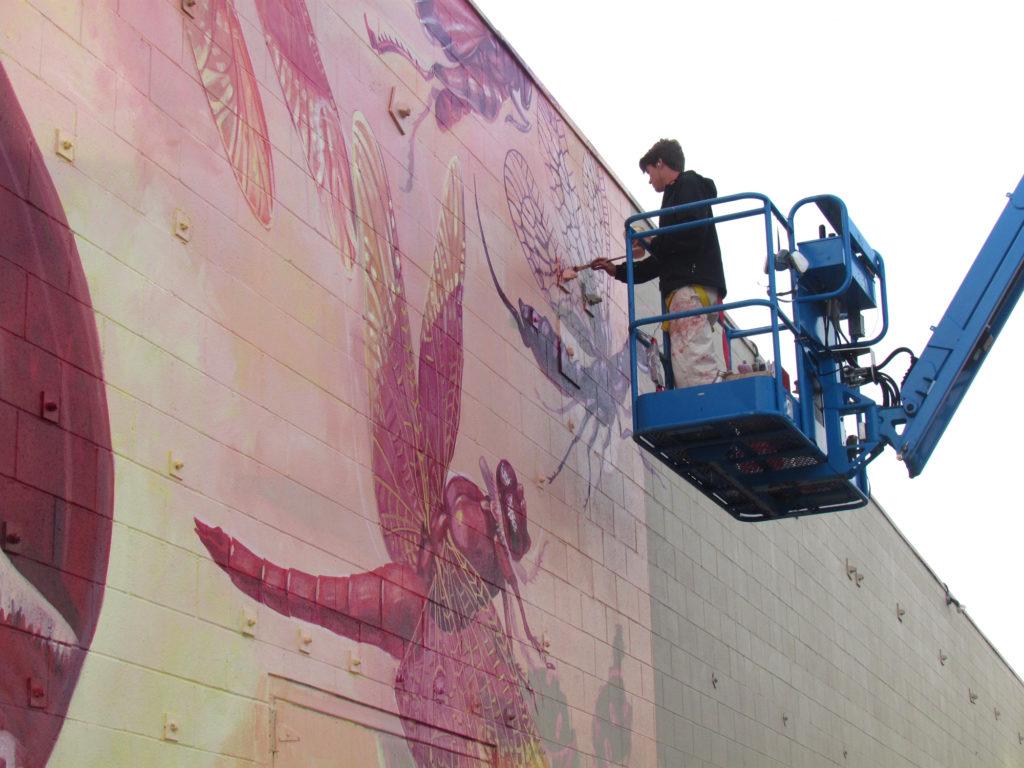
How does the natural world influence your work?
A: Everything about my work is inspired by the natural world, from content to process. My preferred media of choice is watercolor – I love the conversation you need to have with the water (that paint runs the show, not you!), and that you need to give up some control. Growing up in Hawai’i, everything in my life has always been nature- and ocean-focused; I feel like I came from this beautiful place. Everything that comes from my brush is either imagery of the land or sea, and now I get to have this platform to educate and share with people – AMAZING!
J: Nature is the main influence in all of my work. Nature is like a giant puzzle made up of tiny pieces that fit together perfectly. I’m constantly trying to chase that perfection. Recently, my work has been focused on man-made climate change and how a re-connection with nature is essential for a healthy planet.
Tell us about your recent mural for Sea Walls Maui. What inspired you to choose the topic of acidification?
J: Alex and I chose ocean acidification as our topic for our mural because we knew nothing about it. It really stood out on the list of topics to consider because it was so mysterious. What is ocean acidification? Why have we never heard of it? As we did research, we found that it’s a very serious problem caused by CO2 in the atmosphere being absorbed by the ocean. The fact that it’s affecting everything from tiny plankton to entire coral reefs means it has the potential to wipe out all life in the sea. But what also stood out is that there is hope. Although it’s not a permanent solution, some native corals have the ability to fight back against acidification, and replanting these corals can help the rest of the reef.
A: It was really eye-opening to learn about this immense issue. It was kind of like an “oh crap” moment – it’s a HUGE issue with catastrophic consequences; we need to tell everyone about this! And doing that through our mural was the perfect opportunity.
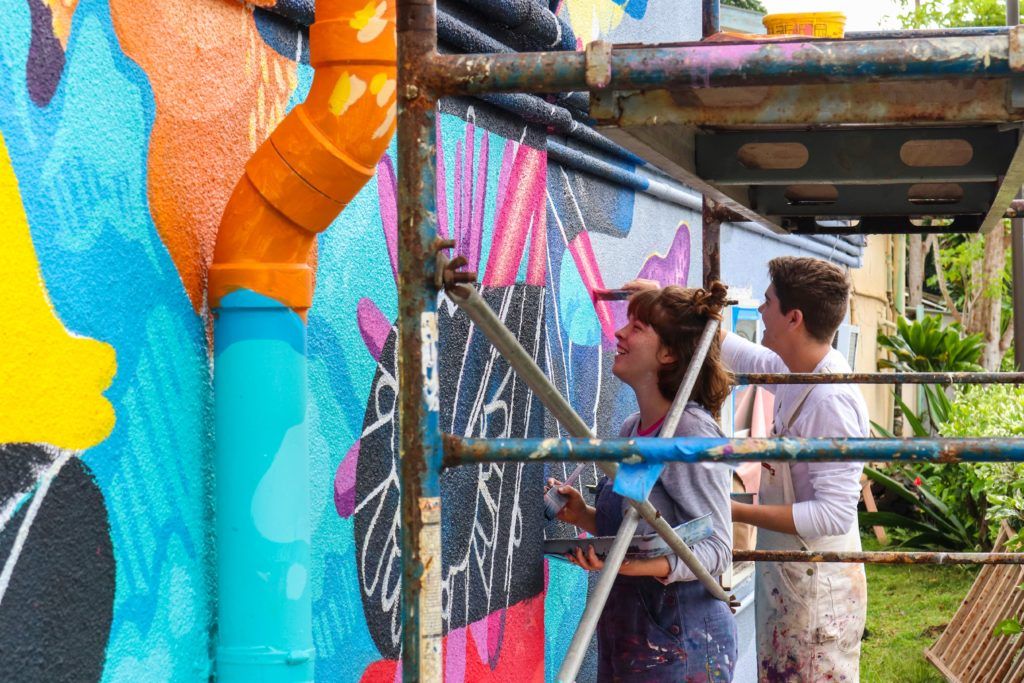
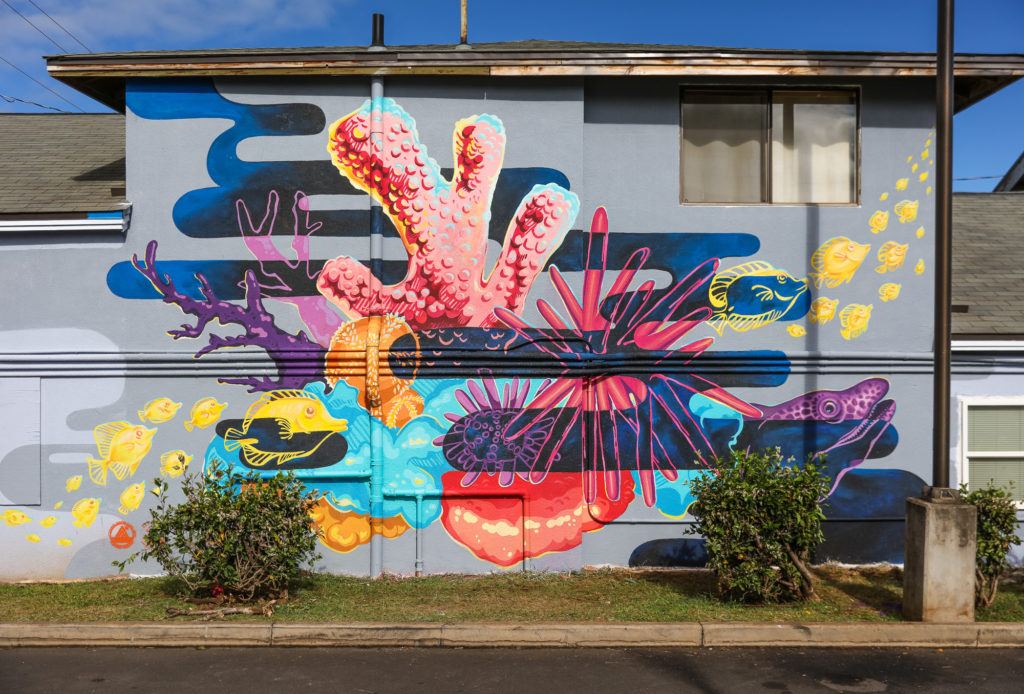
“Native Protector” in Wailuku, Maui. Photo: Tre’ Packard
What do you want people to think or feel when they look at it?
J: Initially, I hope people feel happy. The bright colors of the reef are exaggerated in our mural, and the native coral stands strong in the center of the composition. It might take a while for the viewer to notice the dark shapes running through the painting (symbolizing acidification.) That was intentional.
A: I want people to look at it and see that our actions have consequences. Yes, coral reefs are amazingly beautiful, colorful places, but also, look what’s happening. I want people to see the drastic difference between the bright, vibrant sea life verses the life that’s been overlaid by the “acid.” I want them to think to themselves, “Whoa, what can I do to keep the reef this vibrant?”
How did you not get terribly depressed when doing research on the subject? 🙃
A: Learning about how native corals can help repopulate reefs was a positive finding in our research – although not a permanent solution, it is a small glimmer of hope. And even though it is a lot of overwhelming information to take in – and you feel like, “Geez, what I can even do to fight this?” – being able to create art as a positive form of activism, education, and community engagement was a huge motivator.
J: This is a question I ask myself a lot. It is really easy to get sad when I do research, but the thing that keeps me going is that we are not alone. People everywhere are advocating for change and making change happen. It might take awhile, but change is going to come.
What do you enjoy about painting murals in particular?
A: First and foremost would have to be interacting with the community. You’re creating art for everyone, so it’s really amazing to see people light up when they walk by. I also really like working with Joey. Even though our styles are so different, I think it gives us both a chance to try things we wouldn’t normally. And it’s just really fun painting with your best friend – nonstop dance parties!
J: It’s my favorite form of expression. I love that murals are for the public. People from all backgrounds can walk down the street and have art in their lives. It’s an equalizer. It’s also just super cool painting that big. I love using my whole body to paint. It’s way better than sitting over a desk! Painting murals is a great opportunity to meet and paint with lots of amazing artists and community members. A life of an artist is notoriously lonely, but not when you paint murals. 🙂
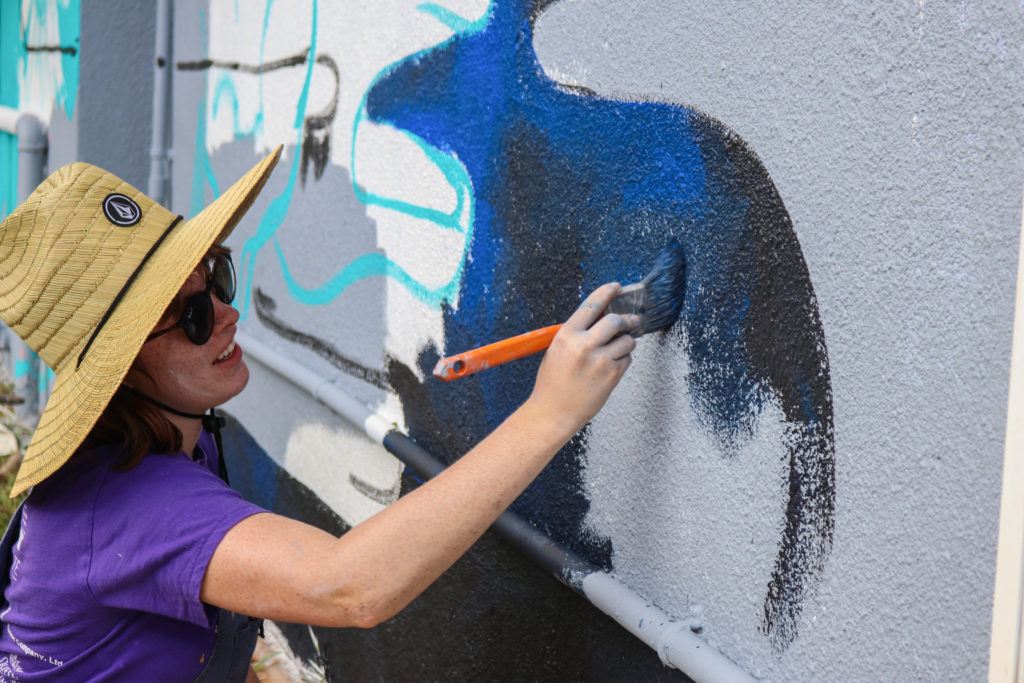
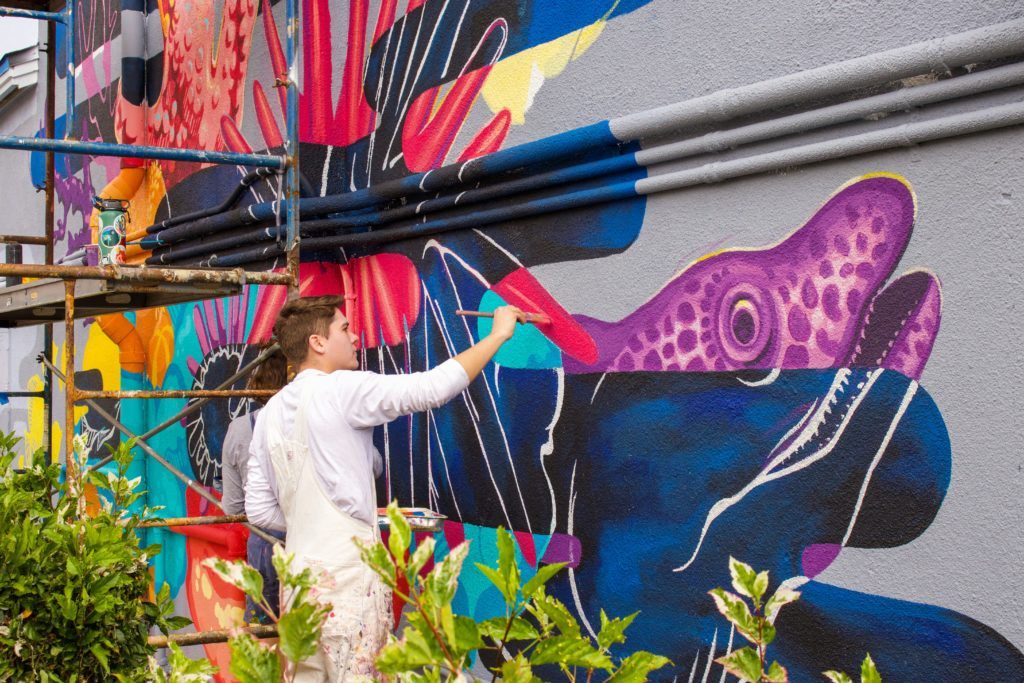
How do you think the arts and creative media can inspire awareness, empathy, and action for our oceans?
A: Because art is so universal, especially public art, it’s something that brings people together and springboards bigger conversation. For example, with our Sea Wall, just the fact that Joey and I were painting these crazy colors on a wall drew people in, got them asking questions, and I think we were able to get a lot of people talking about ocean acidification. Being able to visually depict the issues we’re talking about evokes a greater feeling of empathy. You can really grab someone’s attention with a powerful image.
J: People can understand the effects we are having on our ocean by reading all the terrible figures, numbers, and charts. But in order for change to happen, they must feel emotional about the information. Art creates that emotional response. It’s also a much more positive way to inspire!
Who are some artists, writers, thinkers, or activists that you follow, or who inspire your practice?
A: I LOVE Stacey Rozich. And Tomi Ungerer. He created kids books (Moon Man!) and was a prolific activist.
J: Artists: Andrew Hem, Tristan Eaton, Nychos, Ekundayo, Pichiavo, Smithe, Michael Reeder, Aryz, Etam Cru, Curiot Tlalpazotl… many more! Thinkers/activists: James Hansen, Lisa Levin, Charles David Keeling, Wallace Smith Broeker, Greta Thunberg.
What advice would you give to young people who want to protect the ocean?
J: Stop using plastic! Trying to reduce the amount of plastic you use is the easiest way to help the ocean. Reusable coffee mugs, straws, and silverware are a must! Also, research the issues and let your peers know what you learned!
A: I think a good first step in protecting the ocean would be going to a beach cleanup. The beach cleanup we went to with Sustainable Coastlines Hawaii really opened my eyes to the magnitude of the issues we face. As soon as we walked down the beach one direction, the same amount of trash would wash back up behind us. It really made me aware of my plastic consumption and realize my actions have immense consequences. I think the biggest thing you can do is just go out there and see how our oceans are being impacted. It’s a crazy wake-up call.
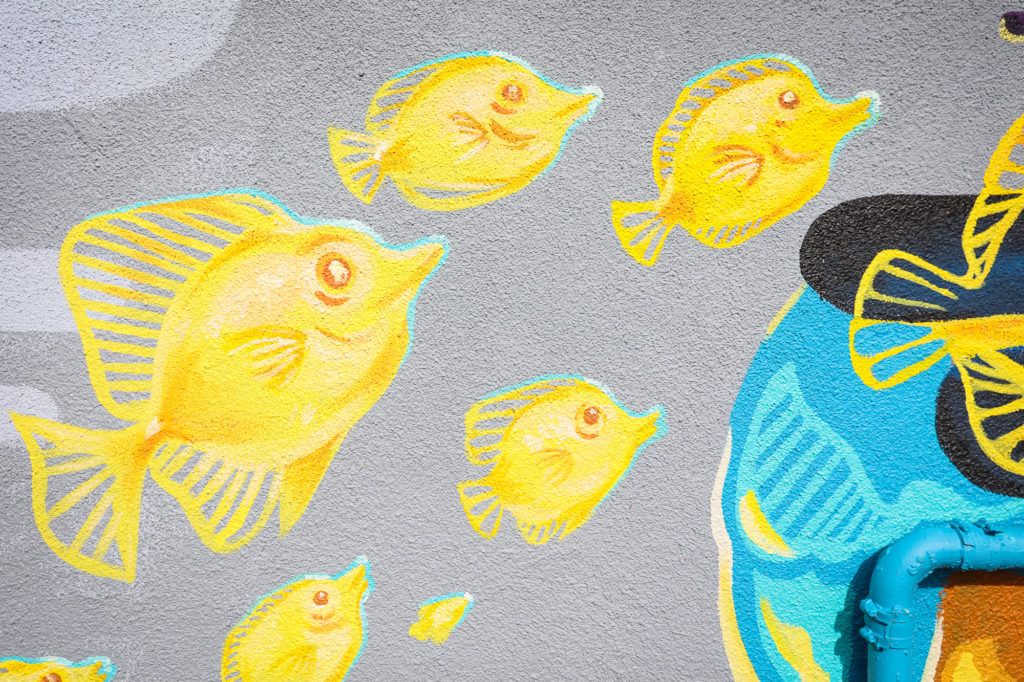
Photo: Tre’ Packard
What advice would you give to young people who want to pursue the arts as a career?
A: DO IT! The “starving artist” stereotype is totally not valid – as long as you are willing to put in the work, be responsible in your business practices, and be authentic in your work, the arts are totally a viable career. YOU have value! Your time and work has value!
J: Just do it! The only thing holding you back is yourself. Anyone can be an artist. It just takes time, dedication, practice, and perseverance.
Find Alex and Joey on Instagram at @underwoodalexandra and @joeyrosestudio
Inspired? ✨ 🐠 Create your own artwork on ocean issues for our 2019 Ocean Awareness Contest: Presence of Future. Accepting visual art, writing, music, and film until June 17th.
Comments are closed for this post.
